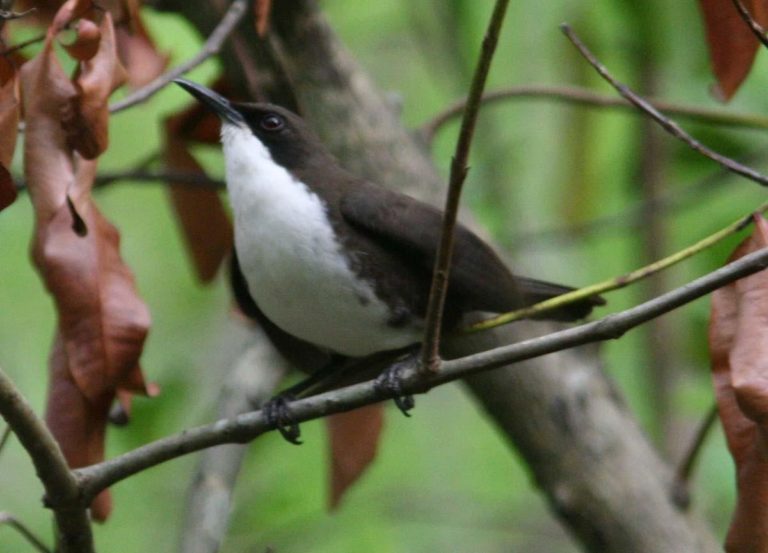Birdfinding.info ⇒ The St. Lucia endemic form of White-breasted Thrasher (and likely separate species) is uncommon, local, endangered, and largely confined to a strip of dry forest habitat along the coast. It is found most regularly at various points along the Micoud Highway between Dennery and Praslin, including the Fregate Island Nature Reserve. North of Dennery, much of its habitat is inaccessible, but it can also be found around Grand Anse and Marquis.
“St. Lucia Thrasher”
Ramphocinclus brachyurus sanctaeluciae
Endemic to St. Lucia, where it occurs in dry deciduous forests along the eastern coast from the Marquis River valley south to Praslin. A 2016 estimate of its total population was around 1,100 individuals, with the vast majority (~84%) along the central coast in Mandelé, south of Dennery.
Identification
A robust thrasher that is almost uniformly dark brown above and white below. In strong light, a blackish mask can be discerned as darker than its brown upperparts.
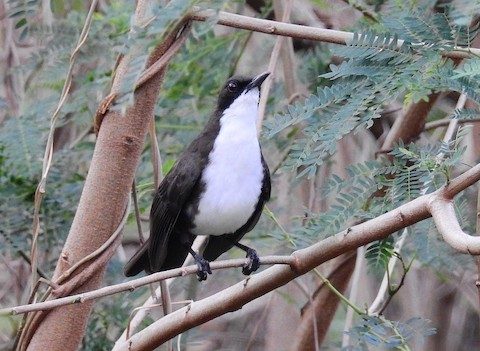
“St. Lucia Thrasher,” R. b. sanctaeluciae. (Dennery, St. Lucia; March 1, 2019.) © Robert Curry
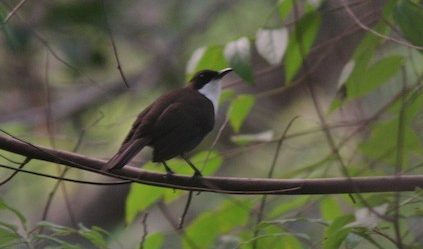
“St. Lucia Thrasher,” R. b. sanctaeluciae. (Dennery, St. Lucia; August 17, 2017.) © Jim Tietz
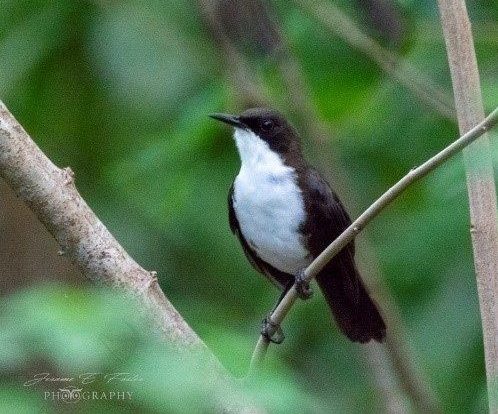
“St. Lucia Thrasher,” R. b. sanctaeluciae. (Praslin, St. Lucia; August 1, 2018.) © Jerome Foster
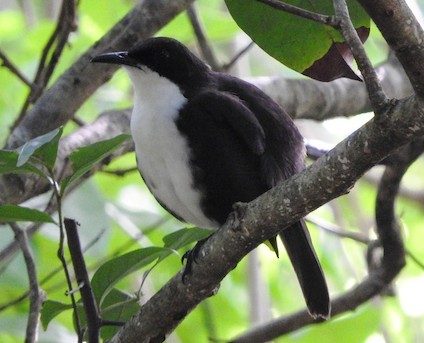
“St. Lucia Thrasher,” R. b. sanctaeluciae. (Dennery, St. Lucia; November 20, 2017.) © Ernie Bradley
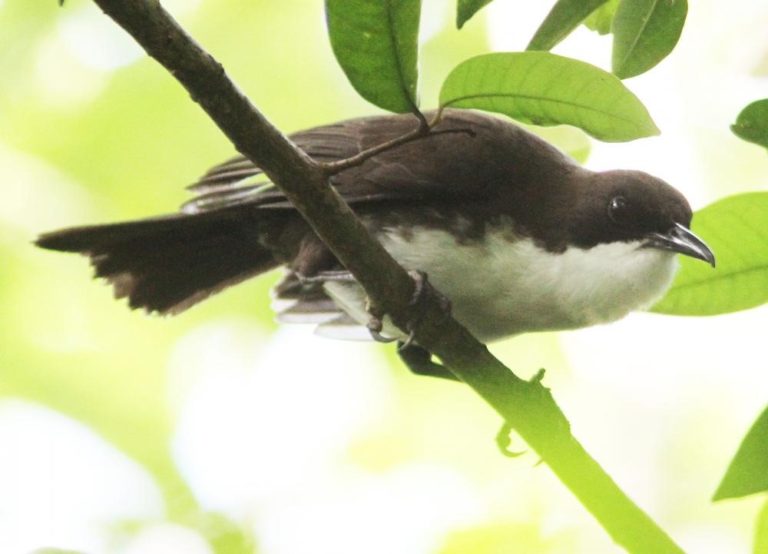
“St. Lucia Thrasher,” R. b. sanctaeluciae. (Fregate Island Nature Reserve, St. Lucia; July 8, 2012.) © Mikko Pyhälä

“St. Lucia Thrasher,” R. b. sanctaeluciae. (Dennery, St. Lucia; October 29, 2018.) © Roger L. Horn
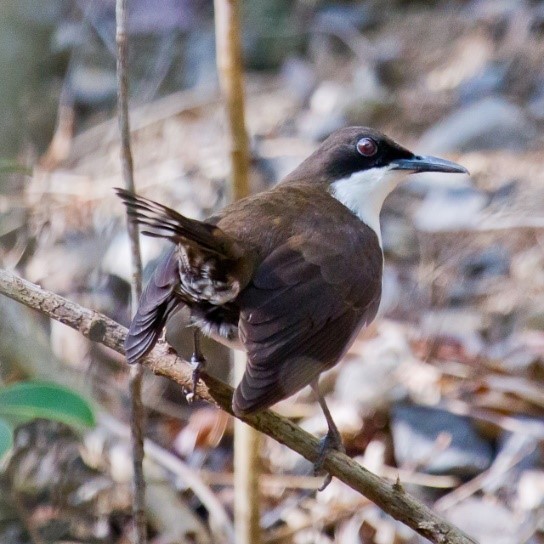
“St. Lucia Thrasher,” R. b. sanctaeluciae, showing warm-brown upperparts in strong sunligh. (St. Lucia; May 15, 2014.) © Peter Garrity

“St. Lucia Thrasher,” R. b. sanctaeluciae. (Dennery, St. Lucia; March 30, 2018.) © Colin D. Jones

“St. Lucia Thrasher,” R. b. sanctaeluciae. (Fregate Island Nature Reserve, St. Lucia; October 29, 2018.) © Roger L. Horn

“St. Lucia Thrasher,” R. b. sanctaeluciae, showing warm-brown upperparts in strong sunligh. (St. Lucia; May 15, 2014.) © Peter Garrity

“St. Lucia Thrasher,” R. b. sanctaeluciae, showing blackish mask and reddish eye. © Robert Curry
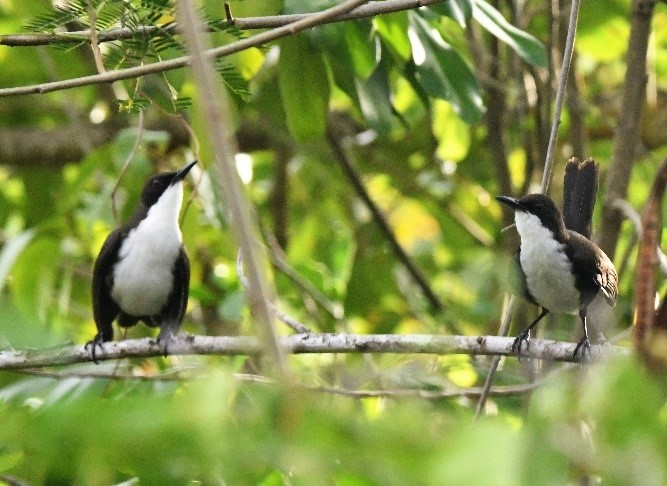
“St. Lucia Thrasher,” R. b. sanctaeluciae, a pair investigating an intruder. (Dennery, St. Lucia; May 14, 2019.) © Bryn Parry
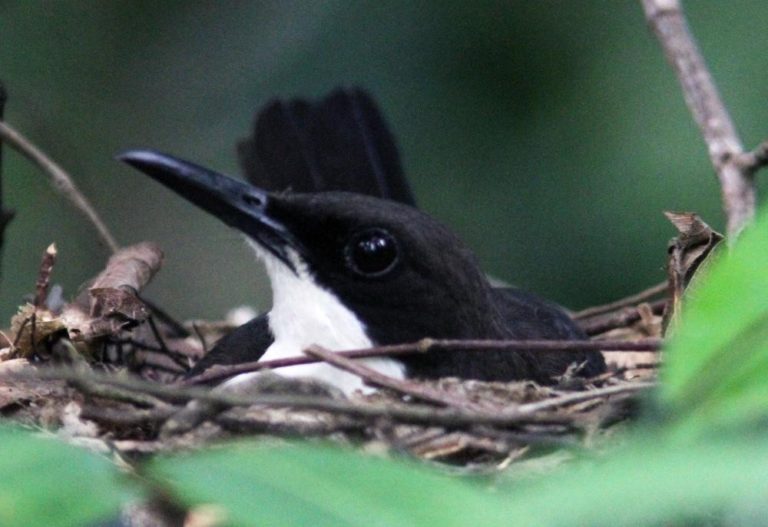
“St. Lucia Thrasher,” R. b. sanctaeluciae, sitting on its nest. (Fregate Island Nature Reserve, St. Lucia; July 8, 2012.) © Mikko Pyhälä
Immatures are more extensively dark brown, with a few whitish blotches on the underparts.

“St. Lucia Thrasher,” R. b. sanctaeluciae, juvenile showing whitish blotches on underparts. (Fregate Island Nature Reserve, St. Lucia; July 19, 2015.) © Rich Bayldon
Voice. Typical song consists of three clear notes followed by a raspy note:
Other recorded vocalizations include a rough, two-syllable call: Macauley Library recording from La Chalupe Ravine, St. Lucia, on May 7, 1971, © James L. Gulledge
Scolding and clucking: Macauley Library recording from La Sourciere River, St. Lucia, on May 28, 1971, © James L. Gulledge
And raspy scolding: Macauley Library recording from La Sourciere River, St. Lucia, on May 18, 1971, © James L. Gulledge; Macauley Library recording from Fregate Island Nature Reserve, St. Lucia, on December 27, 2018, © Justin Watts
Notes
Monotypic form of White-breasted Thrasher that appears likely to be reclassified as a separate species.
IUCN Red List Status: Endangered.
Frontiers of Taxonomy: Two Species of White-breasted Thrasher.
The Martinique and St. Lucia forms of White-breasted Thrasher are very similar in appearance, occupy similar niches on adjacent islands, and have always been classified as a single species. They share approximately the same shape, color pattern, and habitat. Nevertheless, there are consistent differences between them, and a growing body of evidence suggests that they are best regarded as separate species.
The “St. Lucia Thrasher” is about 20% larger overall and has more cleanly contrasting bicolored chocolate-brown-and-white plumage, whereas the “Martinique Thrasher” is paler and grayer above and less immaculate below. Its crown, back, wing coverts have whitish fringes that give it a subtly frosted appearance, and the border between brown and white on its sides tends to show more of a ragged, spotty, gradual color transition—however, both forms could be described this way, so the difference is a matter of degree. In strong light “St. Lucia” appears warm-brown above, whereas “Martinique” appears mostly cold, grayish-brown with a warmer tone on the wings.
Behaviorally, “Martinique Thrasher” appears to be more purely terrestrial than “St. Lucia.” Though they are not fully documented, vocalizations of the two forms also appear to differ. Finally, Miller et al. (2019) have stated that their as-yet unpublished genetic studies indicate that the reproductive isolation of the two forms is older than the divergence of other lineages among the Lesser Antillean mimids.
References
BirdLife International. 2018. Ramphocinclus brachyurus. The IUCN Red List of Threatened Species 2018: e.T22711137A129922471. http://dx.doi.org/10.2305/IUCN.UK.2018-2.RLTS.T22711137A129922471.en. (Accessed November 24, 2019.)
Brewer, D., and B.K. MacKay. 2001. Wrens, Dippers, and Thrashers. Yale University Press. New Haven.
Cody, M. 2019. White-breasted Thrasher (Ramphocinclus brachyurus). In Handbook of the Birds of the World Alive (J. del Hoyo, A. Elliott, J. Sargatal, D.A. Christie, and E. de Juana, eds.). Lynx Edicions, Barcelona. https://www.hbw.com/node/58183. (Accessed November 24, 2019.)
eBird. 2019. eBird: An online database of bird distribution and abundance. Cornell Lab of Ornithology, Ithaca, N.Y. http://www.ebird.org. (Accessed November 24, 2019.)
Gros-Desormeaux, J.-R., T. Lesales, and A.-G. Tayalay. 2015. Behavioral observations on the White-breasted Thrasher (Ramphocinclus brachyurus brachyurus): conservation implications. Acta Ethologica 18: 197-208.
Miller, M., J. DaCosta, J. Mortensen, M. Sorenson, R. Curry, and M. Reed. 2019. Next-generation phylogeny of Caribbean Thrashers. http://mj-miller.net/projects/post/thrashers. (Accessed November 24, 2019.)
Mortensen, J. L., K. F. Freeman, and M. N. Morton. 2014. White-breasted Thrasher (Ramphocinclus brachyurus), version 1.0. In Neotropical Birds Online (T.S. Schulenberg, ed.). Cornell Lab of Ornithology, Ithaca, N.Y. https://doi.org/10.2173/nb.whbthr1.01.
Raffaele, H., J. Wiley, O. Garrido, A. Keith, and J. Raffaele. 1998. A Guide to the Birds of the West Indies. Princeton University Press, Princeton, N.J.
